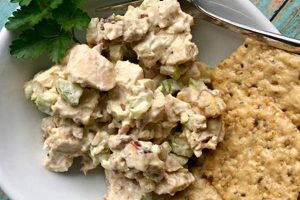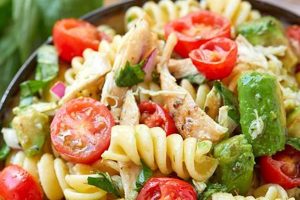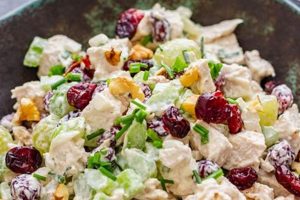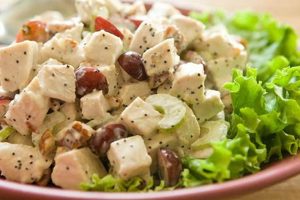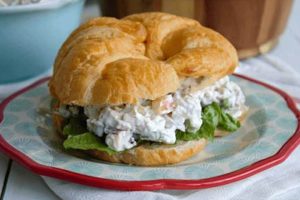Preserved chicken salad, often found in cans or other sealed containers, offers a convenient and shelf-stable meal option. These products typically contain cooked chicken, mayonnaise, and various other ingredients such as celery, onions, or seasonings. An example might include a classic combination of chicken, mayonnaise, celery, and onion, ready to eat directly from the packaging or to incorporate into sandwiches and salads.
The value of such readily available products lies in their ease of use and extended shelf life. This makes them a practical choice for busy individuals, those with limited cooking resources, or situations where refrigeration is unavailable, such as camping or picnics. Historically, canned and preserved foods played a crucial role in expanding food access and providing sustenance beyond harvest seasons. This convenience helped shape modern dietary habits, offering readily available protein sources.
The subsequent sections will delve into specific aspects of preparing and utilizing these convenient protein sources, including nutritional information, creative serving suggestions, and tips for incorporating them into a balanced diet.
Tips for Utilizing Canned Chicken Salad
Maximizing the potential of canned chicken salad involves understanding its versatility and employing techniques that enhance its flavor and presentation. The following tips offer guidance on elevating this convenient ingredient.
Tip 1: Enhance Flavor Profiles: Blandness can be addressed by incorporating fresh herbs such as dill or parsley. A squeeze of lemon juice or a dash of hot sauce can also add depth.
Tip 2: Improve Texture: Adding chopped celery, water chestnuts, or grapes can introduce textural complexity, creating a more satisfying culinary experience.
Tip 3: Elevate Presentation: Serve the chicken salad on crisp lettuce cups, crackers, or within hollowed-out tomatoes for a visually appealing presentation.
Tip 4: Create Sandwiches and Wraps: Canned chicken salad provides a quick and easy filling for sandwiches or wraps. Consider adding sliced cucumbers, tomatoes, or spinach for added nutrients and flavor.
Tip 5: Incorporate into Salads: Utilize canned chicken salad as a protein source in green salads or pasta salads. This offers a convenient way to create a complete and balanced meal.
Tip 6: Explore Casseroles and Baked Dishes: Mix canned chicken salad with cooked pasta, vegetables, and a creamy sauce for a comforting casserole or baked dish.
Tip 7: Consider Dietary Needs: Opt for low-sodium or fat-free varieties when dietary restrictions are a concern. Carefully examine ingredient lists to align with specific dietary needs.
Employing these strategies allows for the transformation of a simple convenience item into a diverse range of flavorful and satisfying meals.
By understanding the potential of canned chicken salad and utilizing these tips, one can appreciate its value beyond mere convenience.
1. Ingredients
Ingredient composition significantly impacts the flavor, texture, nutritional value, and shelf life of canned chicken salad. A thorough understanding of these components is essential for informed consumer choices and recipe adaptations.
- Chicken:
Chicken, the primary ingredient, typically appears as cooked and shredded or diced pieces. Variations in chicken quality, such as white versus dark meat or the presence of skin, influence the final product’s nutritional profile and flavor. Consumers seeking leaner options might prefer products with higher white meat content.
- Mayonnaise:
Mayonnaise provides the characteristic creamy texture and richness. Different formulations, using ingredients like soybean oil, egg yolks, and vinegar, contribute varying levels of fat and flavor. Low-fat or alternative mayonnaise options cater to specific dietary preferences.
- Additives and Preservatives:
Additives and preservatives play a crucial role in extending shelf life and maintaining product stability. Common additions include salt, sugar, and various preservatives. Consumers concerned about sodium intake should examine product labels for sodium content.
- Additional Flavorings:
Ingredients like celery, onion, spices, and herbs create flavor complexity. These components contribute to the overall sensory experience and differentiate various product offerings. Examining the ingredient list allows consumers to select products aligned with their flavor preferences.
The interplay of these ingredients defines the final character of canned chicken salad. Evaluating ingredient lists empowers consumers to select products aligned with their nutritional goals, flavor preferences, and dietary restrictions. This knowledge facilitates informed decisions about incorporating canned chicken salad into a balanced diet.
2. Safety
Safety is paramount when dealing with canned chicken salad. Proper handling and storage are crucial to prevent foodborne illnesses. The canning process itself, while designed to preserve food, does not eliminate all risks. Spoilage organisms can survive if the canning procedure is inadequate or if the can’s integrity is compromised. Dented, bulging, or leaking cans indicate potential contamination and should be discarded immediately. Consuming contents from such cans can lead to botulism, a severe and potentially fatal form of food poisoning.
Temperature control plays a critical role in maintaining the safety of canned chicken salad. Storing unopened cans at room temperature is generally safe, but once opened, refrigeration is essential. Exposure to higher temperatures, particularly after opening, provides an ideal environment for bacterial growth. Refrigerated chicken salad should be consumed within three to five days to minimize the risk of spoilage. Freezing is generally not recommended as it can negatively affect the texture and consistency of the product.
Careful attention to expiration dates is another vital safety precaution. Consuming canned chicken salad beyond its expiration date increases the risk of foodborne illness. While the product may appear and smell normal, harmful bacteria can proliferate beyond the expiration date, posing a health hazard. Adhering to these safety guidelines minimizes the risks associated with consuming canned chicken salad and ensures a safe and enjoyable dining experience.
3. Storage
Proper storage is crucial for maintaining the quality, safety, and flavor of canned chicken salad. Understanding appropriate storage techniques prevents spoilage and ensures the product remains palatable and safe for consumption. Storage considerations vary depending on whether the can is unopened or opened.
- Unopened Cans:
Unopened cans of chicken salad should be stored in a cool, dry place, away from direct sunlight and extreme temperatures. A pantry or cupboard typically provides suitable conditions. Avoid storing cans near heat sources such as ovens or stoves, as this can compromise the can’s integrity and accelerate spoilage. Proper storage helps maintain product quality within the manufacturer’s specified shelf life.
- Opened Cans:
Once opened, canned chicken salad requires refrigeration to prevent bacterial growth and maintain freshness. Transfer the remaining contents to an airtight container and store it in the refrigerator at a temperature of 40F (4C) or below. Prompt refrigeration minimizes the risk of foodborne illness and helps preserve the product’s flavor and texture. Opened canned chicken salad should be consumed within three to five days.
- Freezing:
Freezing canned chicken salad is generally not recommended. The freezing process can alter the texture and consistency of the mayonnaise, resulting in a less desirable product upon thawing. While freezing might extend the storage duration, the quality compromise often outweighs the benefit. Alternative preservation methods, such as incorporating the chicken salad into a freezer-friendly casserole before freezing, might be considered if long-term storage is desired.
- Thawing (If Frozen):
If canned chicken salad is frozen (despite recommendations against it), thaw it slowly in the refrigerator to minimize texture changes. Avoid thawing at room temperature, as this can promote bacterial growth. Consume the thawed product promptly and do not refreeze it. Thawing and refreezing can further degrade the quality and increase the risk of foodborne illness.
Adhering to these storage guidelines ensures the safety and quality of canned chicken salad, allowing consumers to enjoy this convenient food item without compromising their health or the product’s intended flavor and texture.
4. Preparation
Preparation, while minimal for canned chicken salad due to its pre-cooked nature, remains a crucial step in optimizing flavor and incorporating the product into various dishes. Understanding the nuances of preparation ensures a more satisfying culinary experience. While the product is ready to eat directly from the can, several techniques can elevate its taste and versatility.
- Draining Excess Liquid:
Canned chicken salad often contains excess liquid which can dilute the flavor and create a watery consistency. Draining this liquid before serving concentrates the flavor and improves the texture. This step is especially important when using the chicken salad as a sandwich filling or incorporating it into other dishes where excess moisture is undesirable.
- Mixing and Incorporating Additional Ingredients:
While canned chicken salad is a complete product on its own, incorporating additional ingredients can enhance its flavor profile and nutritional value. Chopped celery, onions, grapes, or nuts can add textural complexity and flavor. Fresh herbs, spices, or a squeeze of lemon juice can brighten the flavor and add depth. Mixing these ingredients thoroughly ensures even distribution and a balanced taste.
- Temperature Considerations:
Serving canned chicken salad chilled enhances its flavor and freshness. Refrigerating the can before opening or chilling the prepared salad for a short period before serving improves palatability. Avoid letting the product sit at room temperature for extended periods, particularly after opening, to maintain food safety and quality.
- Portioning and Serving:
Appropriate portioning ensures controlled calorie intake and prevents food waste. Serving the chicken salad on bread, crackers, lettuce cups, or as part of a larger salad offers diverse presentation options. Considering portion sizes and complementary ingredients contributes to a balanced and visually appealing meal.
Even though canned chicken salad requires minimal preparation, attention to these details optimizes its culinary potential. Thoughtful preparation elevates the product from a simple convenience item to a versatile ingredient suitable for a range of dishes and culinary creations.
5. Serving Suggestions
Serving suggestions provide a crucial link between the convenience of canned chicken salad and its realization as a versatile ingredient in various culinary applications. These suggestions offer consumers practical guidance on transforming a simple pantry staple into a range of dishes, expanding its utility beyond a standalone snack. Effective serving suggestions consider the product’s existing flavor profile and texture while exploring complementary ingredients and presentation methods to create appealing and balanced meals. For example, a recipe might suggest incorporating canned chicken salad into a croissant sandwich with lettuce and tomato, highlighting its role as a quick and easy protein source in a light lunch. Alternatively, a suggestion to combine the product with pasta, grapes, and walnuts elevates it to a more substantial salad suitable for a larger meal. The availability of diverse serving suggestions directly influences consumer perception and utilization of canned chicken salad.
Furthermore, serving suggestions can address specific dietary needs and preferences. Recipes targeting health-conscious consumers might emphasize low-sodium product varieties and incorporate fresh vegetables or whole-grain bread for added nutritional value. Suggestions for those seeking quick meal solutions might focus on minimal preparation steps and readily available ingredients. Conversely, more elaborate recipes could cater to individuals interested in culinary exploration, offering unique flavor combinations and creative presentation techniques. For instance, a recipe might suggest using canned chicken salad as a filling for bell peppers or combining it with curry powder and chutney for an Indian-inspired appetizer. This adaptability broadens the product’s appeal and encourages culinary experimentation.
Ultimately, well-crafted serving suggestions enhance the perceived value of canned chicken salad by demonstrating its versatility and potential within a broader culinary context. They empower consumers to utilize the product effectively, transforming a convenient staple into a diverse range of satisfying and nutritious meals. This connection between product and application is essential for maximizing consumer engagement and ensuring the product’s continued relevance in a dynamic food landscape. Addressing potential challenges, such as perceived limitations in flavor or texture, through innovative and appealing serving suggestions strengthens the product’s position as a versatile and convenient culinary resource.
6. Nutritional Value
Nutritional value represents a critical consideration within the context of canned chicken salad recipes. Formulations vary significantly depending on ingredients and processing methods, directly impacting health and dietary suitability. Sodium content, for instance, often poses a concern in canned goods. Recipes emphasizing low-sodium ingredients or incorporating techniques to mitigate sodium levels become essential for individuals managing hypertension or other sodium-sensitive conditions. Similarly, fat content, derived primarily from mayonnaise, influences caloric density and overall dietary impact. Recipes utilizing lower-fat mayonnaise alternatives or incorporating ingredients that enhance satiety without excessive fat contribute to healthier meal options. The protein content, derived from the chicken itself, provides essential amino acids crucial for muscle building and repair. Understanding the protein source, whether white or dark meat, and its proportion within the product informs dietary choices aligned with individual protein requirements.
Real-world examples illustrate this connection. A recipe featuring canned chicken salad with high sodium content, served on white bread, offers limited nutritional value compared to a recipe utilizing low-sodium chicken salad combined with whole-grain bread and a variety of fresh vegetables. The latter provides complex carbohydrates, fiber, vitamins, and minerals, contributing to a more balanced and nutritious meal. Further, understanding the nutritional composition of canned chicken salad empowers consumers to make informed choices when incorporating it into their diets. Choosing products with lower sodium, fat, and added sugar content, alongside recipes emphasizing nutrient-rich additions, aligns with dietary guidelines promoting overall health and well-being. For individuals managing specific dietary restrictions, such as gluten intolerance or dairy allergies, understanding ingredient lists becomes paramount. Recipes may need adaptation to accommodate such restrictions while maintaining nutritional balance.
In conclusion, nutritional value is inextricably linked to the formulation and application of canned chicken salad recipes. Careful consideration of ingredients, preparation methods, and serving suggestions allows consumers to maximize nutritional benefits while minimizing potential dietary drawbacks. This understanding empowers individuals to incorporate canned chicken salad into healthy and balanced dietary patterns, contributing to overall health and well-being while enjoying the convenience of this versatile food item. Addressing the nutritional aspects of canned chicken salad recipes directly empowers consumers to make informed choices, promoting a more thoughtful and health-conscious approach to utilizing this convenient food item.
7. Variations
Variations in canned chicken salad recipes represent a significant factor influencing consumer choice and culinary application. These variations stem from diverse ingredient combinations, processing techniques, and flavor profiles, impacting the product’s nutritional value, taste, and overall appeal. A key variation lies in the type of chicken used. Recipes utilizing white meat exclusively often cater to health-conscious consumers seeking leaner protein sources, while those incorporating dark meat offer a richer flavor profile and potentially higher iron content. The choice of mayonnaise also contributes significantly to variations. Traditional mayonnaise, low-fat mayonnaise, and even plant-based alternatives produce distinct textural and flavor differences, influencing the overall sensory experience. Further variations arise from the inclusion of additional ingredients. Recipes incorporating grapes, cranberries, or apples introduce sweetness and textural contrast, while the addition of celery, onions, or water chestnuts provides a more savory and crunchy element. Spice blends, ranging from mild curry powder to zesty chipotle peppers, further diversify flavor profiles, catering to a wider range of palates. For example, a classic canned chicken salad recipe might feature diced celery and onion, while a curried variation incorporates raisins, curry powder, and almonds, offering a distinct flavor profile rooted in Indian cuisine. Similarly, a “chunky” style emphasizes larger chicken pieces and less mayonnaise, appealing to consumers preferring a heartier texture.
The practical significance of understanding these variations extends beyond mere flavor preference. Nutritional content, storage stability, and suitability for specific diets all depend on the recipe’s composition. A low-sodium variation caters to individuals managing sodium intake, while a recipe utilizing gluten-free ingredients accommodates dietary restrictions. Recipes emphasizing shelf-stable ingredients become essential for emergency preparedness or outdoor activities where refrigeration is limited. Furthermore, exploring variations unlocks creative culinary applications. A classic chicken salad recipe might serve as a sandwich filling or the base for a light salad, while a spicier variation transforms into a dip for crackers or a filling for stuffed avocados. Recognizing these possibilities broadens the utility of canned chicken salad, allowing consumers to integrate it into diverse meal plans and culinary scenarios.
In summary, variations within canned chicken salad recipes represent a dynamic interplay of ingredients, processing techniques, and flavor profiles, impacting not only taste but also nutritional value, storage considerations, and culinary versatility. Understanding these variations empowers consumers to make informed choices aligned with dietary needs, flavor preferences, and intended applications. This awareness transforms a simple convenience item into a versatile culinary resource adaptable to a wide array of dishes and dietary requirements. Challenges related to perceived limitations in flavor or texture are often addressed through innovative variations that expand the appeal and broaden the applications of canned chicken salad.
Frequently Asked Questions
This section addresses common inquiries regarding canned chicken salad, providing concise and informative responses to clarify potential uncertainties and misconceptions.
Question 1: How long can unopened canned chicken salad be stored safely?
Unopened cans typically remain safe for consumption within two to five years from the production date, provided they are stored in a cool, dry environment. Always refer to the “best by” date printed on the can for specific product guidance.
Question 2: What are the signs of spoilage in canned chicken salad?
Spoilage indicators include a swollen or bulging can, leakage, foul odor upon opening, or an unusual appearance or texture of the contents. Discard the product immediately if any of these signs are present.
Question 3: Is it safe to freeze canned chicken salad?
Freezing is generally not recommended due to potential negative effects on texture and consistency. Mayonnaise-based products often separate and become watery upon thawing.
Question 4: How long can opened canned chicken salad be stored in the refrigerator?
Opened canned chicken salad should be refrigerated in an airtight container and consumed within three to five days to minimize spoilage risk.
Question 5: Can canned chicken salad be used in cooked dishes?
While primarily consumed cold, canned chicken salad can be incorporated into cooked dishes like casseroles, provided it is added towards the end of the cooking process to avoid overcooking and texture degradation.
Question 6: Are there low-sodium varieties of canned chicken salad available?
Low-sodium and other dietary variations exist. Carefully review product labels to select options aligned with specific dietary needs and preferences.
Understanding these aspects contributes to the safe and effective utilization of canned chicken salad, maximizing its convenience and culinary potential while prioritizing food safety and dietary considerations.
For further information or specific dietary guidance, consulting a registered dietitian or referring to reputable food safety resources is recommended.
Conclusion
Examination of canned chicken salad recipes reveals a multifaceted food item offering both convenience and culinary versatility. Factors influencing quality, safety, and nutritional value include ingredient composition, processing methods, storage practices, and preparation techniques. While shelf-stable and ready-to-eat, optimizing flavor and incorporating the product into diverse dishes requires attention to these aspects. Nutritional considerations, particularly sodium and fat content, necessitate informed consumer choices and recipe adaptations to align with dietary guidelines and individual health goals. Variations in formulations, incorporating diverse ingredients and flavor profiles, further expand culinary applications and consumer appeal.
Ultimately, the successful utilization of canned chicken salad hinges on informed decision-making. Awareness of safety protocols, nutritional implications, and creative serving suggestions allows this convenient staple to contribute positively to a balanced and varied diet. Further exploration and development of innovative recipes promise to expand the culinary potential of canned chicken salad while addressing evolving dietary needs and consumer preferences.

